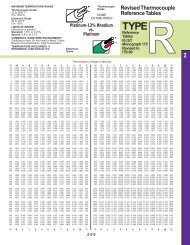Using Thermocouples
Using Thermocouples
Using Thermocouples
Create successful ePaper yourself
Turn your PDF publications into a flip-book with our unique Google optimized e-Paper software.
( )<br />
To DVM<br />
R L<br />
LEAKAGE RESISTANCE<br />
Figure 27<br />
R S<br />
R S<br />
To DVM<br />
R L<br />
T 2<br />
R S<br />
T 1<br />
R S<br />
VIRTUAL JUNCTION<br />
Figure 28<br />
Z<br />
If the thermocouple wire is small, its series resistance,<br />
R S , will be quite high and under extreme conditions R L<br />
< < R S . This means that the thermocouple junction will<br />
appear to be at R L and the output will be proportional to<br />
T 1 not T 2 .<br />
High temperatures have other detrimental effects on<br />
thermocouple wire. The impurities and chemicals within<br />
the insulation can actually diffuse into the thermocouple<br />
metal causing the temperature-voltage dependence to<br />
deviate from published values. When using<br />
thermocouples at high temperatures, the insulation<br />
should be chosen carefully. Atmospheric effects can be<br />
minimized by choosing the proper protective metallic or<br />
ceramic sheath<br />
Galvanic Action<br />
The dyes used in some thermocouple insulation will<br />
form an electrolyte in the presence of water. This<br />
creates a galvanic action, with a resultant output<br />
hundreds of times greater than the Seebeck effect.<br />
Precautions should be taken to shield thermocouple<br />
wires from all harsh atmospheres and liquids.<br />
Thermal Shunting<br />
No thermocouple can be made without mass. Since it<br />
takes energy to heat any mass, the thermocouple will<br />
slightly alter the temperature it is meant to measure. If<br />
the mass to be measured is small, the thermocouple<br />
must naturally be small. But a thermocouple made with<br />
small wire is far more susceptible to the problems of<br />
contamination, annealing, strain, and shunt impedance.<br />
To minimize these effects, thermocouple extension wire<br />
can be used. Extension wire is commercially available<br />
wire primarily intended to cover long distances between<br />
the measuring thermocouple and the voltmeter.<br />
Extension wire is made of metals having Seebeck<br />
coefficients very similar to a particular thermocouple<br />
type. It is generally larger in size so that its series<br />
resistance does not become a factor when traversing<br />
long distances. It can also be pulled more readily<br />
through a conduit than can very small thermocouple<br />
wire. It generally is specified over a much lower<br />
temperature range than premium grade thermocouple<br />
wire. In addition to offering a practical size advantage,<br />
extension wire is less expensive than standard<br />
thermocouple wire. This is especially true in the case of<br />
platinum-based thermocouples.<br />
Since the extension wire is specified over a narrower<br />
temperature range and it is more likely to receive<br />
mechanical stress, the temperature gradient across the<br />
extension wire should be kept to a minimum. This,<br />
according to the gradient theory, assures that virtually<br />
none of the output signal will be affected by the<br />
extension wire.<br />
Noise - We have already discussed line-related noise<br />
as it pertains to the data acquisition system. The<br />
techniques of integration, tree switching and guarding<br />
serve to cancel most line-related interference.<br />
Broadband noise can be rejected with the analog filter.<br />
The one type of noise the data acquisition system<br />
cannot reject is a dc offset caused by a dc leakage<br />
current in the system. While it is less common to see dc<br />
leakage currents of sufficient magnitude to cause<br />
appreciable error, the possibility of their presence<br />
should be noted and prevented, especially if the<br />
thermocouple wire is very small and the related series<br />
impedance is high.<br />
Wire Calibration<br />
Thermocouple wire is manufactured to a certain<br />
specification, signifying its conformance with the NBS<br />
tables. The specification can sometimes be enhanced<br />
by calibrating the wire (testing it at known<br />
temperatures). Consecutive pieces of wire on a<br />
continuous spool will generally track each other more<br />
closely than the specified tolerance, although their<br />
output voltages may be slightly removed from the center<br />
of the absolute specification.<br />
If the wire is calibrated in an effort to improve its<br />
fundamental specifications, it becomes even more<br />
imperative that all of the aforementioned conditions be<br />
heeded in order to avoid decalibration.<br />
Z-30














